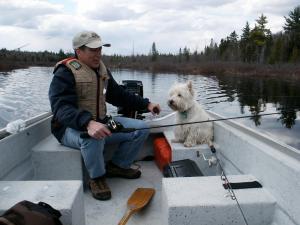 My first trip to Brown Lake . . . early exposure to one of my greatest buddies . . . Layton Ford.
My first trip to Brown Lake . . . early exposure to one of my greatest buddies . . . Layton Ford.
I am a Grand Manan trout fisherman. It goes like this. When you get to the fishing hole, you cut a pole from an alder that is as straight as you can find. Then you reach into your pocket and extract the two inch piece of wood with fishing line wrapped around it. This is the tip of the alder that you cut on your last fishing trip. You unwind the line and then rewind it on the tip of the new pole. When you are done fishing, you cut two inches off the end of the pole and head home.
But this is Layton land and he does it right.
We are in a boat.
We have casting rods.
We are wearing life jackets.
We have a tackle box that has a crazy assortment of lures, all designed for some unknown specific purpose.
I have never fished bass before. They have nests. One of my first casts lands in a tree. Layton tells me that the nests are on the bottom of the lake as he tries to pull the line free.
You cast the line in the water and then seductively pull it over the nest where mother bass is caring for eggs. Either she likes pretty things or she’s just in a nasty mood and grabs the lure and you have your fish.
Layton is an expert at this process. I, on the other hand, am a complete novice and the day passes without much success. I decide to change lures. I want something pretty. There, in the box, is a chrome “Deep Pig”. Layton watches me put it on my line, silently thinking that I’ll never catch anything with something that looks like the bumper of a ’57 Chevy.
I get it on without injury and make my first cast. It is about as heavy as the Chevy bumper as well. True to form, rather than the cast sailing in front of me, it goes over my head behind me. I turn around to see this great splash that looks a bit suspicious and all of a sudden the fight is on. I think that I’ve hit the “lunker” right on the head and he’s just mad.
A “lunker” is an abnormally large fish, commonly a bass.
Finally we get the bass in the boat. Standard operating procedures are to weigh the fish, take a trophy picture, cut a notch out of one of the fins after checking to see if someone else has caught and notched it before, (this is because most of the fishing in Brown lake is catch and release . . . unwritten etiquette among cottage owners on this private lake) . . . and then to release the fish.
If you release the fish, it gets bigger in the lake and in the story that you tell about your catch.
I was just thinking about how similar this is to being fishers-of-men in Christendom’s modern stock pond. We are all fishing for “lunkers”, in the “market-share-of-Christians pool”. It’s catch and release from a spiritual perspective and we call it evangelism.
If you were to play a “sit-down-if-the-church-you-are-attending-is-the-first-you-have-attended” game in a typical Sunday service in North America, you would see very few “fish” that had never been hooked and landed before. Our pews are full of “lunkers” whose fins are multiply notched from the many times that they have been previously won to Christ or at least the church.
We are expert fishermen.
We have tackle boxes full of shiny and pretty things designed to attract the attention of the fish or make them mad enough to bite.
If you want to find fish that may never have been caught before, I would recommend an old alder pole, lots of bug spray and a difficult trek to some back woods pond not normally fished.
There are lots of those places that the church would consider too difficult to get to. But until we decide that this is our mission, we’ll just be re-notching “lunkers” pulled from the stock pond.

Recent Comments